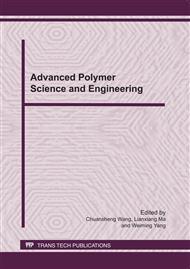p.66
p.72
p.78
p.85
p.90
p.95
p.99
p.104
p.111
Hydrophobic Modification of Natural Cellulose Fiber with MMA via Surface-Initiated ARGET ATRP
Abstract:
To convert the hydrophilic cotton fiber into hydrophobic, grafting methyl methacrylate (MMA) on cotton fiber surface using ARGET (activators regenerated by electron transfer) ATRP (atom transfer radical polymerization) was studied in this paper. Four parallel experiments with different reaction time (2h/4h/6h/8h) were designed. The modified cotton fibers and the untreated control were examined using FTIR, SEM and contact angle analysis. The results show that as the reaction time prolonged, the peak of carbonyl stretching band of 2-bromoester at 1730cm-1 was stronger and the surface of cotton fiber was rougher, which demonstrates MMA has been grafted on the surface of cotton fiber successively and its amount increases with the reaction time. As the results of contact angle measurement, it shows that the hydrophilicity of cotton fiber can easily be modified by grafting of MMA, but the increasing amount of grafting chain had no obvious effects on further improving its hydrophobicity.
Info:
Periodical:
Pages:
90-94
Citation:
Online since:
March 2011
Authors:
Price:
Сopyright:
© 2011 Trans Tech Publications Ltd. All Rights Reserved
Share:
Citation:


